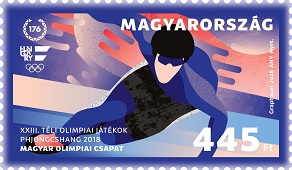
XXIII. Téli Olimpiai Játékok - Phjongcshang - Bélyeg
A Magyar Posta a Magyar Olimpiai Bizottsággal történő együttműködés keretében bélyegkiadással köszönti a téli sportok 2018-as legnagyobb eseményét, a XXIII. Téli Olimpiai Játékokat. Az alkalmi bélyeg Héjja Luca és Ördögh László grafikusművészek tervei szerint az ANY Biztonsági Nyomdában készült. A kiadvány 2018. február 2-án jelenik meg, és ettől az időponttól kapható az elsőnapi postákon, a Filapostán, továbbá megrendelhető a Magyar Posta internetes áruházából is.
A világ sportot kedvelő közössége két héten keresztül a dél-koreai Phjongcshangra figyel, ahol 2018. február 8. és 25. között rendezik a XXIII. Téli Olimpiai Játékokat.
Phjongcshang már a 2010-es és 2014-es téli játékokra is pályázott, végül harmadszorra, a Nemzetközi Olimpiai Bizottság 2011-ben tartott szavazásán már az első körben elnyerte a rendezés jogát. A 700 méter tengerszint feletti magasságban elterülő település és annak környéke nagyszerű hely a téli sportokat kedvelők számára. Az esemény lehetőséget biztosít a világ legkiválóbb sportolóinak arra, hogy tökéletes létesítményekben, ideális helyszínen küzdjenek meg egymással, dicsőséget szerezve maguknak és az őket delegáló országoknak.
A magyar csapat legnépesebb különítményét a rövidpályás gyorskorcsolyázók adják, mivel mind a férfi, mind a női váltó részvételi jogot szerzett, így a maximális tíz fővel utazhatnak a játékokra. Hazánk eddig hat érmet – két ezüstöt és négy bronzot – szerzett a téli olimpiákon, valamennyit műkorcsolyában. Legutóbb 1980-ban a Regőczy Krisztina, Sallay András jégtáncpáros lett második Lake Placidben.
A bélyegen az egyik új magyar sikersportág, a rövidpályás gyorskorcsolya egy pillanatát örökítették meg az alkotók, az alkalmi borítékon egy síelő sziluettje látható. Az alkalmi bélyegző fő motívuma a bélyegen is megtalálható babérkoszorúba foglalt 176-os szám, ami a magyar színekben indult sportolók eddig megszerzett olimpiai aranyérmeinek számát jelenti.
A szervezők elképzelései szerint a játékok sikeres megrendezése segíteni fogja a téli sportok további népszerűsítését és elterjedését Ázsiában, hozzájárul a dél-koreai Kangvon régió gazdasági fejlődéséhez, továbbá ösztönözni fogja újabb és újabb sportban tehetséges generációk bekapcsolódását az olimpiai mozgalomba.










